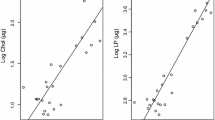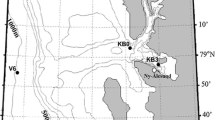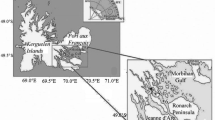Abstract
During various seasons from May 2001 until July/August 2003, the lipid dynamics of the pteropod Clione limacina from Kongsfjorden, Svalbard, were investigated with respect to ontogenetic development and life-cycle. Polytrochous larvae, which were dominant in spring (April, May), composed the lipid-richest specimens of the population, with total lipid of about 50% of dry mass (%DM). Major lipid classes were triacylglycerols (TAG) and 1-O-alkyldiacylglycerol ethers (DAGE), accounting on average for 53.1 and 21.9% of total lipid, respectively. Until summer, larvae grew to adults by utilising their storage lipids. In July/August, lipids were depleted to about 10%DM due to maturation and reproduction. Almost all animals in autumn (September) were mature and able to replenish their lipid deposits by accumulating DAGE (26.7%) and TAG (39.6%). This is probably the prerequisite for successful overwintering.
Principal component analysis (PCA), based on the fatty acid compositions, revealed ontogenetic differences between polytrochous larvae, and small and full-grown adults. Higher proportions of 18:4(n-3) and 14:0 were found in polytrochous larvae and smaller adults during spring. Both fatty acids were highly significantly correlated with the proportions of TAG, which were used for growth and development because they are presumably easier to metabolise. PCA also divided C. limacina specimens into DAGE-rich and DAGE-poor. We suggest that DAGE are a long-term energy store and hypothesise that they are necessary during periods of food scarcity, but may also serve as an energy source for reproduction. The fatty acids 17:1(n-8), 15:0, 16:1(n-7) and 18:1(n-7) were significantly correlated with the proportion of DAGE but not with TAG. These fatty acids, which do not originate from their only prey, Limacina helicina, are synthesised de novo. Their abundance reflects an efficient lipid production by C. limacina. Based on the results of lipid biosynthesis and accumulation in combination with the population structure, we suggest that C. limacina has at least a 2-year life-cycle in Svalbard waters.





Similar content being viewed by others
References
Ackman RG, Hingley HJ (1965) The occurrence and retention of dimethyl-ß-propiothetin in some filter feeding organisms. J Fish Res Board Can 25:267–284
Clarke A (1983) Life in cold water: the physiological ecology of polar marine ectotherms. Oceanogr Mar Biol Annu Rev 21:341–453
Clarke KR, Warwick RM (2001) Change in marine communities: an approach to statistical analysis and interpretation, 2nd edn. Primer-E, Plymouth
Conover RJ, Lalli CM (1972) Feeding and growth in Clione limacina (Phipps), a pteropod mollusc. J Exp Mar Biol Ecol 9:279–302
Conover RJ, Lalli CM (1974) Feeding and growth in Clione limacina (Phipps), a pteropod mollusc. II. Assimilation, metabolism and growth efficiency. J Exp Mar Biol Ecol 16:131–154
Dalsgaard J, St John M, Kattner G, Müller-Navarra D, Hagen W (2003) Fatty acid trophic markers in the pelagic marine environment. Adv Mar Biol 46:225–340
Falk-Petersen S (1981) Ecological investigations on the zooplankton community in Balsfjorden, northern Norway: seasonal changes in the lipid class composition of Meganyctiphanes norvegica (M. Sars), Thysanoessa raschii (M. Sars), and T. inermis (Krøyer). J Exp Mar Biol Ecol 54:209–224
Falk-Petersen S (1985) Growth of the euphausiids Thysanoessa inermis, Thysanoessa raschii, and Meganyctiphanes norvegica in a sub-Arctic fjord, North Norway. Can J Fish Aquat Sci 42:14–22
Falk-Petersen S, Hagen W, Kattner G, Clarke A, Sargent JR (2000) Lipids, trophic relationships and biodiversity in Arctic and Antarctic krill. Can J Fish Aquat Sci 57:178–191
Falk-Petersen S, Sargent JR, Kwasniewski S, Gulliksen B, Millar R-M (2001) Lipids and fatty acids in Clione limacina and Limacina helicina in Svalbard waters and the Arctic Ocean: trophic implications. Polar Biol 24:163–170
Fay L, Richli U (1991) Location of double bonds in polyunsaturated fatty acids by gas chromatography-mass spectrometry after 4,4-dimethyloxazoline derivatisation. J Chromatogr 541:89–98
Folch J, Lees M, Sloane-Stanley GH (1957) A simple method for the isolation and purification of total lipides from animal tissues. J Biol Chem 226:497–509
Gannefors C, Böer M, Kattner G, Graeve M, Eiane K, Gulliksen B, Hop H, Falk-Petersen S (2005) The Arctic sea butterfly Limacina helicina; lipids and life strategy. Mar Biol (in press)
Gilmer RW, Harbison GR (1991) Diet of Limacina helicina (Gastropoda: Thecosomata) in Arctic waters in midsummer. Mar Ecol Prog Ser 77:125–134
Graeve M, Hagen W, Kattner G (1994) Herbivorous or omnivorous? On the significance of lipid compositions as trophic markers in Antarctic copepods. Deep Sea Res 41:915–924
Hagen W (1988) Zur Bedeutung der Lipide im antarktischen Zooplankton. Ber Polarforsch 49:1–129
Hop H, Pearson T, Hegseth EN, Kovacs KM, Wiencke C, Kwasniewski S, Eiane K, Mehlum F, Gulliksen B, Wlodarska-Kowalczuk M, Lydersen C, Weslawski JM, Cochrane S, Gabrielsen GW, Leakey RJG, Lønne OJ, Zajaczkowski M, Falk-Petersen S, Kendall M, Wängberg S-Å, Bischof K, Voronkov AY, Kovaltchouk NA, Wiktor J, Poltermann M, di Prisco G, Papucci C, Gerland S (2002) The marine ecosystem of Kongsfjorden, Svalbard. Polar Res 21:167–208
Hopkins TL (1985) Food web of an Antarctic midwater ecosystem. Mar Biol 89:197–212
Hopkins TL (1987) Midwater food web in McMurdo Sound, Ross Sea, Antarctica. Mar Biol 96:93–106
Ikeda T (1972) Chemical composition and nutrition of zooplankton in the Bering Sea. In: Takenouti YA (ed) Biological oceanography of the northern North Pacific Ocean. Idemitsu Shoten, Tokyo, pp 433–442
Kattner G, Fricke HSG (1986) Simple gas-liquid chromatography method for the simultaneous determination of fatty acids and alcohols in wax esters of marine organisms. J Chromatogr 361:263–268
Kattner G, Hagen W, Graeve M, Albers C (1998) Exceptional lipids and fatty acids in the pteropod Clione limacina (Gastropoda) from both polar oceans. Mar Chem 61:219–228
Keller MD, Bellows WK, Guillard RRL (1989) Dimethylsulfide production in marine phytoplankton. In: Saltzman ES, Cooper WJ (eds) Biogenic sulphur in the environment. American Chemical Society, Washington, DC, pp 167–182
Lalli CM (1970) Structure and function of the buccal apparatus of Clione limacina (Phipps) with a review of feeding in gymnosomatous pteropods. J Exp Mar Biol Ecol 4:101–118
Lalli CM, Gilmer RW (1989) Pelagic snails. The biology of holoplanktonic gastropod molluscs. Stanford University Press, Stanford, Calif, p 259
Lee RF (1974) Lipids of zooplankton from Bute Inlet, British Columbia. J Fish Res Board Can 31:1577–1582
Lee RF (1975) Lipids of Arctic zooplankton. Comp Biochem Physiol 51B:263–266
Lee RF (1991) Lipoproteins from the hemolymph and ovaries of marine invertebrates. In: Gilles R (ed) Advances in comparative and environmental physiology, vol 7. Springer, Berlin Heidelberg New York, pp 187–207
Lee RF, Hirota J, Barnett AM (1971) Distribution and importance of wax esters in marine copepods and other zooplankton. Deep Sea Res 18:1147–1165
Lebour MV (1931) Clione limacina in Plymouth waters. J Mar Biol Assoc UK 17:785–795
Levasseur M, Keller MD, Bonneau E, D’Amours D, Bellows WK (1994) Oceanographic basis of a DMS-related Atlantic cod (Gadus morhua) fishery problem: blackberry feed. Can J Fish Aquat Sci 51:881–889
Mayzaud P, Chanut JP, Ackman RG (1989) Seasonal changes of biochemical composition of marine particulate matter with special reference to fatty acids and sterols. Mar Ecol Prog Ser 56:189–204
McCarigal K, Cushman S, Stafford S (2002) Multivariate statistics for wildlife and ecology research. Springer, Berlin Heidelberg New York, p 283
McCullagh P, Nelder JA (1989) Generalized linear models. Chapman & Hall, London
Meisenheimer J (1905) Die arktischen Pteropoden. Fauna Arct 4:408–430
Mileikovsky SA (1970) Breeding and larval distribution of the pteropod Clione limacina in the North Atlantic, Subarctic and North Pacific Oceans. Mar Biol 6:317–334
Olsen RE, Henderson RJ (1989) The rapid analysis of neutral and polar marine lipids using double-development HPTLC and scanning densitometry. J Exp Mar Biol Ecol 129:189–197
Pelseneer P (1887) Report on the Pteropoda collected by H.M.S. Challenger during the years 1873–76. I. The Gymnosomata. Sci Rep “Challenger” Zool 19:1–74
Phleger CF, Nicols PD, Virtue P (1997) Lipids and buoyancy in Southern Ocean pteropods. Lipids 32:1093–1100
Phleger CF, Nelson MM, Mooney BD, Nichols PD (2001) Interannual variations in the lipids of the Antarctic pteropods Clione limacina and Clio pyramidata. Comp Biochem Physiol 128B:553–564
Sargent JR (1989) Ether-linked glycerides in marine animals. In: Ackman RG (ed) Marine biogenic lipids, fats and oils. CRC Press, Boca Raton, pp 176–193
Sargent JR, Henderson RJ (1986) Lipids. In: Corner EDS, O’ Hara E (eds) Biological chemistry of marine copepods. University Press, Oxford, pp 59–108
Svendsen H, Beszczynska-Møller A, Hagen JO, Lefauconnier B, Tverberg V, Gerland S, Ørbaek JB, Bischof K, Papucci C, Zajaczkowski M, Azzolini R, Bruland O, Wiencke C, Winther J-G, Dallmann W ( 2002) The physical environment of Kongsfjorden-Krossfjorden, an Arctic fjord system in Svalbard. Polar Res 21:133–166
Acknowledgements
We are grateful to the captain and crew of “Oceania” and “Lance” and the staff of Kings Bay AS at Ny-Ålesund for their professional support during field experiments. For their advice on statistics, we thank Werner Wosniok (University of Bremen), Kirsten Dau, Thorsten Dittmar and Thomas Brey. We are grateful for the constructive comments of Richard Crawford and an anonymous reviewer. This work was supported by the Personnel Exchange Programme between the Research Council of Norway and Deutscher Akademischer Austauschdienst (DAAD).
Author information
Authors and Affiliations
Corresponding author
Additional information
Communicated by M. Kühl, Helsingør
Rights and permissions
About this article
Cite this article
Böer, M., Gannefors, C., Kattner, G. et al. The Arctic pteropod Clione limacina: seasonal lipid dynamics and life-strategy. Marine Biology 147, 707–717 (2005). https://doi.org/10.1007/s00227-005-1607-8
Received:
Accepted:
Published:
Issue Date:
DOI: https://doi.org/10.1007/s00227-005-1607-8




